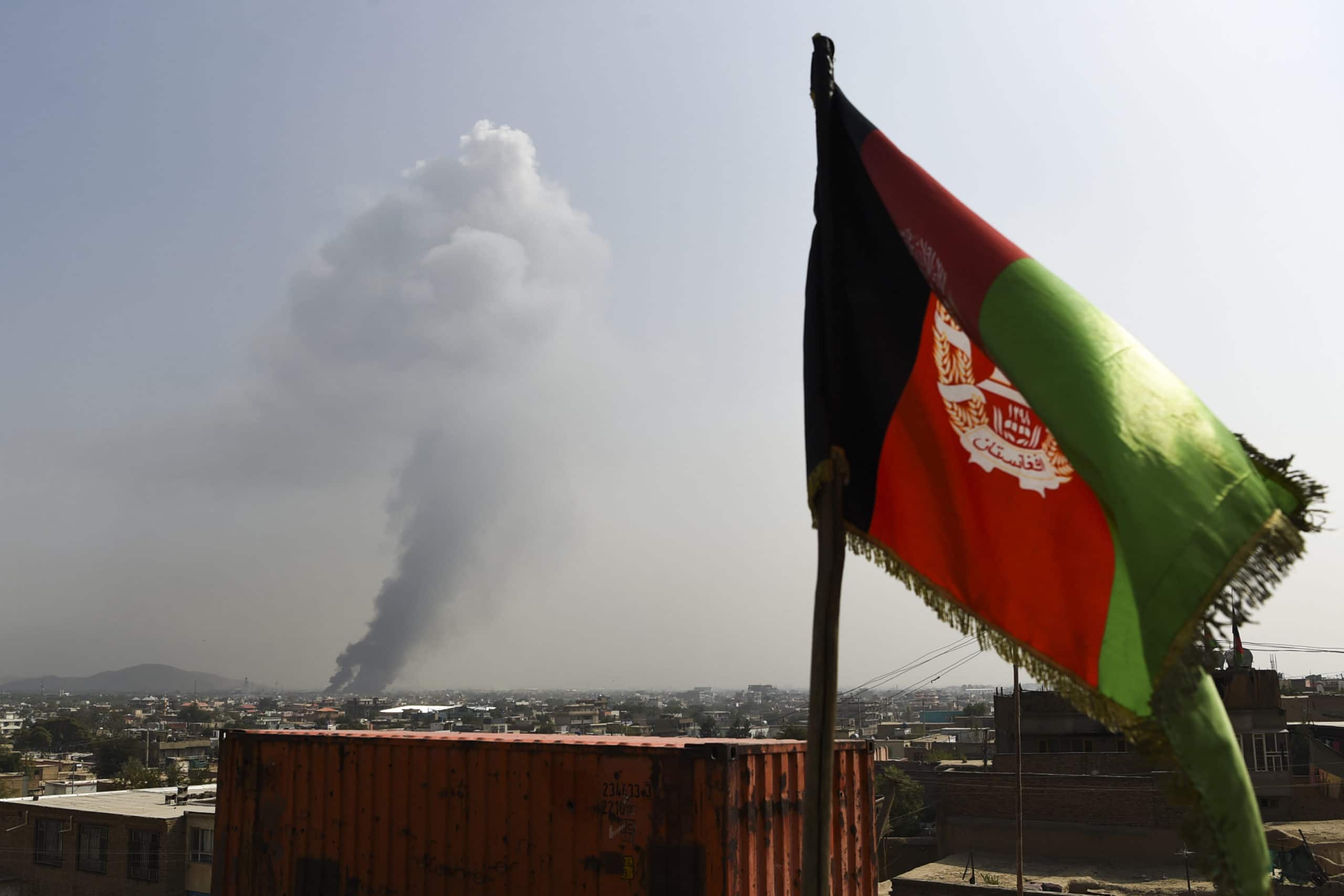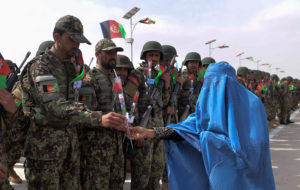January 14, 2021 | From Trump to Biden Monograph
Afghanistan
January 14, 2021 | From Trump to Biden Monograph
Afghanistan
Current Policy
The Trump administration’s policy toward Afghanistan swung erratically between a 2017 decision to increase U.S. troop levels and wage the war more effectively, and an all-out effort late in the president’s term to negotiate a full withdrawal in the face of steady Taliban advances on the battlefield. The latter reflected President Trump’s increased efforts to “end the endless wars” not only in Afghanistan but also in Iraq, Syria, Somalia, and other countries where the United States has engaged jihadists since al-Qaeda’s 9/11 attack.
In August 2017, following a lengthy policy review, Trump announced that – despite his “original instinct … to pull out” – he would add approximately 4,000 troops to the 8,500 already in Afghanistan. Trump declared, “Our troops will fight to win,” including “obliterating ISIS, crushing al-Qaeda [and] preventing the Taliban from taking over the country.” Trump loosened the military’s restrictive rules of engagement and vowed that any subsequent drawdown of troops would be conditions-based, not timeline-based, which had been the preference of his predecessor, President Obama.
As part of his announcement, Trump said the United States would pressure Pakistan to cease its support for the Taliban. In 2018, the administration suspended up to $1.3 billion of military assistance in response to Pakistan’s failure to crack down on terrorist groups. In an effort to show that it was serious in the fight against the Islamic State in Afghanistan, Trump also authorized the use of the Massive Ordinance Air Blast against a cave complex – the largest non-nuclear bomb ever dropped in combat.
After Trump appointed Zalmay Khalilzad as the U.S. special advisor on Afghanistan, the United States and the Taliban commenced negotiations in Qatar in late 2018. After several fits and starts, a U.S.-Taliban agreement was signed on February 29, 2020. The Trump administration hailed the four-page document as a peace deal that would end the decades-long war in Afghanistan.1 Trump said, “I really believe the Taliban wants to do something to show that we’re not all wasting time.”2 He also said that the Taliban “will be killing terrorists,” including al-Qaeda, despite the fact that the group historically has been a steadfast ally of the Taliban.3 Similarly, Secretary of State Mike Pompeo proclaimed that the Taliban “agreed that they would break that relationship and that they would work alongside of us to destroy, deny resources to and have Al Qaeda depart from that place.”4

Smoke rises from the site of a Taliban attack in early September 2019 that killed at least 16 people in a residential area of Kabul, launched even as the terrorist group and Washington were negotiating a peace deal.
(Photo by Wakil Kohsar/AFP via Getty Images)
The agreement has four parts. First, it includes “guarantees and enforcement mechanisms” that would prevent Afghanistan from being used by terror groups. However, the agreement does not detail what the guarantees are or how the enforcement mechanisms are to be managed.
Second, a “timeline for the withdrawal of all foreign forces from Afghanistan” was established. The United States agreed to conduct a phased withdrawal of its forces, with all troops leaving the country by April 2021. The Taliban, in turn, agreed to halt attacks on U.S. forces.
Third, after the first two conditions are satisfied, “the Taliban will start intra-Afghan negotiations with Afghan sides.” The Taliban, which do not recognize the Afghan government as legitimate, refuse to negotiate with it directly, hence the term “Afghan sides.” The Afghan government is to be but one party among other elements of civil society.
Fourth, a “permanent and comprehensive ceasefire,” as well as “the completion and agreement over the future political roadmap of Afghanistan,” are to be discussed at the so-called intra-Afghan talks. There are no conditions in the agreement for a “reduction in violence.” Nor is there a requirement for a ceasefire to begin at any particular time.
Assessment
Just one year after Trump’s much-anticipated announcement of his Afghanistan policy in 2017, he backtracked. The administration opened up negotiations with the Taliban before any tangible gains were made on the battlefield. In fact, the Taliban’s grinding military campaign allowed them to gain control of, or influence over, a significant percentage of Afghan districts throughout the country. The Taliban were not losing ground; they were slowly gaining it. Pakistan, once seen as a major contributor to the problems in Afghanistan, was suddenly characterized as a partner in peace.5 And Qatar, which had played host to the Taliban’s embassy and sheltered some of their fighters over the years, was cast as a neutral host for peace talks.
By September 2019, the United States and the Taliban were on the cusp of signing a deal. It was called off by the president when the Taliban killed an American soldier. Despite this, both parties signed the agreement five months later. While the deal has been described as a peace agreement, it is not. Nowhere does it state that the United States and the Taliban, or the Afghan government and the Taliban, have ended hostilities. Nor is a ceasefire between the Afghan government and the Taliban a requirement. It is an item to be discussed at a future date. If anything, the deal ensures that the United States leaves Afghanistan in exchange for nebulous Taliban assurances that they will not allow terror groups to attack the United States or its allies. Put another way, the agreement is a withdrawal deal, not a peace deal.6
Despite promises to the contrary from U.S. officials, the Taliban have neither denounced al-Qaeda nor hunted down or turned over a single al-Qaeda leader or operative. The deal calls for “enforcement mechanisms” to ensure the Taliban will not support terror groups. Yet no mechanisms have been put in place.7

An Afghan woman wearing a burqa gives roses to Afghan National Army soldiers during a ceremony at a military base in the Guzara district of Afghanistan’s Herat province on February 28, 2019. (Photo by Hoshang Hashimi /AFP via Getty Images)
Prior to 9/11, the Taliban said that they would not allow Afghan soil to be used to attack U.S. interests. The Taliban lied then, and there is no reason they should be trusted now. In fact, to this day, the Taliban deny al-Qaeda even has a presence in Afghanistan, which is obviously false.89 Al-Qaeda, which is still operating in Afghanistan, found the deal to be so favorable that it publicly endorsed the agreement.10 Any deal should have first required the Taliban to renounce al-Qaeda and hunt down or expel remaining al-Qaeda operatives from the country.11
The Trump administration was so eager to make a deal that it excluded the Afghan government from talks. This was because the Taliban refuse to recognize the Afghan government, which they view not only as “un-Islamic” and “illegitimate,” but also as a “puppet” of the United States and the West.12 In the agreement, the United States committed the Afghan government to freeing 5,000 Taliban prisoners, even though the Afghan government was not part of the negotiations. This somewhat ironically reinforced the Taliban’s view that the Afghan government is a U.S. puppet.
In short, the Trump administration’s deal legitimized the Taliban, delegitimized the Afghan government, and provided the Taliban with further incentives to attack the Afghan government, all while absolving the Taliban of their crime of harboring al-Qaeda both before and after 9/11. Taliban attacks against the Afghan government have spiked. The Taliban see themselves as the victors of the war and have repeatedly vowed not to share power with the Afghan government.
Recommendations
The political will to ensure that the Taliban do not regain power and that al-Qaeda and other terror groups do not retain safe havens in Afghanistan remains absent across the American political spectrum. Yet Taliban-al-Qaeda relations remain as strong as ever; the Taliban are stronger today than at any point since 9/11; and al-Qaeda is still a potent threat to the United States.
Therefore, the United States has compelling national security interests in preventing the Taliban from regaining control of Afghanistan and in limiting the terrorist threat emanating from South Asia. The Biden administration should implement several policies to that end:
- Immediately put an end to the withdrawal deal with the Taliban. The existing deal benefits only the Taliban. It does not ensure a Taliban break with al-Qaeda, has no enforcement mechanisms built in, delegitimizes the Afghan government, and raises the Taliban’s stature in the international community. If the Biden administration is determined to leave Afghanistan despite the fact that there are compelling U.S. national security interests in remaining, no deal is required to do so.
- Disrupt the Taliban’s state-building project. The Taliban’s ultimate goal is to return to power, restore their Islamic Emirate of Afghanistan (the official name of their government from 1996 to 2001), and impose their harsh brand of Sharia on the Afghan people. If the Biden administration is willing to keep a presence in the country, U.S. forces can continue to train and support Afghan forces that battle the Taliban. American airpower remains an effective check on the Taliban. In mid-October 2020, U.S. air support helped the Afghan government prevent Helmand’s provincial capital of Lashkar Gah from falling to the Taliban.
- Keep military options open. If the United States does not wish to retain troops in Afghanistan, it still has the means to help slow the return of the Taliban to power and the resurgence of al-Qaeda. Washington can continue to provide military aid and economic and diplomatic support to the Afghan government and its forces. The United States can also encourage regional countries that have interests in seeing the Taliban fail, such as India, to support the Afghan government.
- Isolate the Taliban diplomatically. The United States must roll back a decade’s worth of efforts to legitimize the Taliban as a responsible actor in Afghanistan and in the international community. The Taliban’s political office in Doha, Qatar, should be shut down immediately. The Taliban use this office to promote themselves as the true government of Afghanistan as well as to fundraise and develop contacts throughout the Middle East and beyond. All talk of delisting Taliban leaders from the UN sanctions regime must end. Taliban political, military, and propaganda leaders and operatives should be added to the UN sanctions list.
- Increase pressure on Pakistan. Without the support of the Pakistani state, the Taliban insurgency would be a shell of itself. The Taliban rely on Pakistan for safe haven. The Taliban operate recruiting offices, training camps, religious schools, weapons and ammunition storage depots, hospitals, and safe houses in Pakistan. Families of senior and mid-level Taliban leaders live in Pakistan with the approval of the government. The Pakistani military and its Inter-Services Intelligence Directorate provide weapons, munitions, and advice to the Taliban’s military. The United States must apply meaningful pressure on Pakistan to get it to end this support. A sanctions regime similar to the one targeting Iran should be implemented to pressure the Pakistani government to cease its support for the Taliban.
